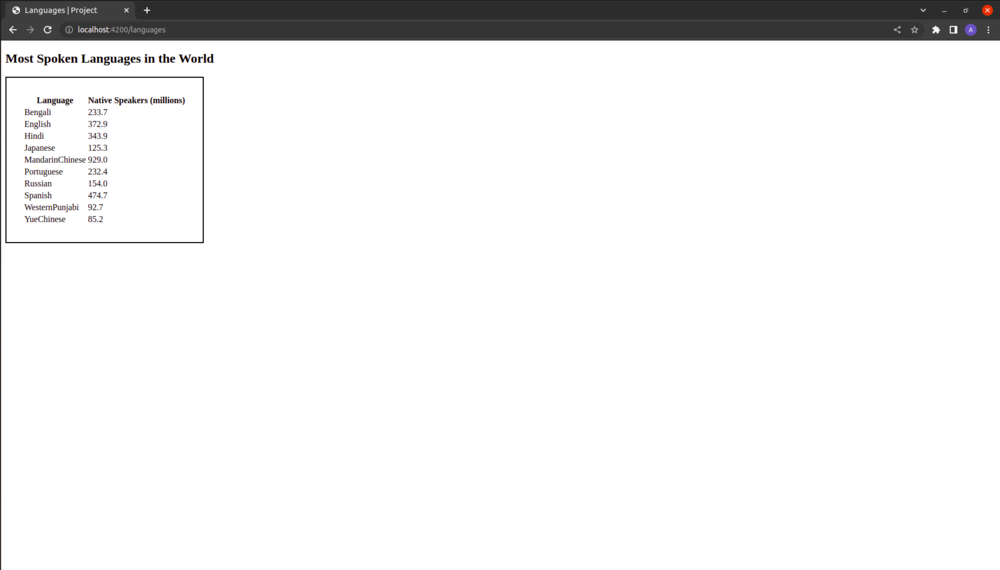Ember.js ArrayProxy Class
Last Updated :
10 Jan, 2023
Ember.js is an open-source JavaScript framework used for developing large client-side web applications which is based on Model-View-Controller (MVC) architecture. Ember.js is one of the most widely used front-end application frameworks. It is made to speed up development and increase productivity. Currently, it is utilized by a large number of websites, including Square, Discourse, Groupon, Linked In, Live Nation, Twitch, and Chipotle.
ArrayProxy Class:
The ArrayProxy class acts as a wrapper object which forwards all requests to any other object that implements Array and/or MutableArray. The ability to change out the underlying array is advantageous in a variety of binding use cases, as well as in other situations.
Methods: The following is the list of methods for this class.
- addObject: This method is used to push an object onto the end of the array if the object is not a present array.
- addObjects: This method is used to add a number of objects to the array.
- addObserver: This method is used to register an observer for a property.
- any: This method is used to check if there are any objects in the target that matches the condition laid by the callback function.
- cacheFor: This method is used to get the cached value for an already computed property if it exists.
- clear: This method removes all the elements in the array
- compact: This method is used to make a copy of an array without null and undefined elements.
- decrementProperty: This method is used to set the value of the property to the current value minus some amount.
- destroy: This method destroys an object by setting the isDestroyed flag and deleting its metadata.
- every: This method is used to check if all objects in the array pass a specific callback function.
- filter: This method is used to filter objects in the array according to a specific condition.
- filterBy: This method is used to return an array with just the items with the matched property.
- find: This method is used to find elements that match the given callback function.
- findBy: This method is to get the first item with a property matching the passed value.
- forEach: This method is used to run a function on every item of the array.
- get: This method is used to retrieve the value of a property from the object.
- getEach: This method is used to get all values in the array for a given key.
- getProperties: This method is used to get the value of multiple properties at once.
- includes: This method is used to check if a given object is present in the array or not.
- incrementProperty: This method is used to set the value of the property to the current value plus some amount.
- indexOf: This method is used to find the index of a given object in the array.
- init: This method is called when objects are instantiated.
- insertAt: This method is used to insert an object in a specific position in the array.
- invoke: This method is used to call the passed method on every object in the receiver that implements it.
- isAny: This method is used to check if for anyone the element in the array the passed property resolves to the desired value or not.
- isEvery: This method is used to check if, for each element in the array, the passed property resolves to the desired value or not.
- lastIndexOf: This method is used to find the last index of an object in the array.
- map: This method is used to map all items in the array with a specific function.
- mapBy: This method is used to get the value of the named property on all items in the list.
- notifyPropertyChange: This method alerts the observer system that a property change has taken place.
- objectAt: This method is used to retrieve the object at a given index.
- objectAtContent: This method is used to retrieve the object at the specified index from the content.
- objectsAt: This method is used to fetch items for the given array of indices.
- popObject: This method is used to pop objects from an array.
- pushObject: This method is used to push an object into an array.
- pushObjects: This method is used to push multiple objects into an array.
- reduce: This method is used to combine the values of the array into a single value.
- reject: This method provides a list of all the enumerated elements for which the provided function returns false.
- rejectBy: This method returns an array containing the objects for which the given key’s value is false.
- removeAt: This method is used to remove elements on a given index.
- removeObject: This method removes all instances of the object from the array.
- removeObjects: This method removes each supplied item from the given array.
- removeObserver: This method removes any observers you have registered earlier for this object.
- replace: This method is used to replace some of the elements in the array with the given objects.
- replaceContent: This method in fact swaps out the designated objects on the content array.
- reverseObjects: This method reverses the elements in the array.
- set: This method is used to set the key and value to the object.
- setEach: This method, for each member, sets the value of the named property.
- setObjects: This method replaces the receiver’s content with the argument’s substance.
- setProperties: This method sets a number of properties at once.
- shiftObject: This method shifts nil, if there are no more, or an object from the array’s beginning.
- slice: This method is used to return a new array that is a portion of the receiver.
- sortBy: This method is used to sort an array by the specified key.
- toArray: This method just transforms the object into a real array.
- toString: This method is to get the string representation of the object.
- toggleProperty: This method is used to set the value of the boolean property to the opposite of its current value.
- uniq: This method returns a brand-new array with just unique values in it.
- uniqBy: This method is used to get objects which unique values for the given key.
- unshiftObject: This method is used to add a single object to the start of the array.
- unshiftObjects: This method is used to add objects to the front of the array.
- willDestroy: This method tears down the object.
- without: This method gives back a new array without the given value.
Properties: The following is the list of the properties of this class:
- []: This property is used to get or set the array content.
- arrangedContent: This property defines the array the proxy represents itself as.
- concatenatedProperties: This property specifies the characteristics from the superclass that will be concatenated
- content: This property is used to forward the object property.
- firstObject: This property is used to retrieve the first object of the array.
- isDestroyed: This property is the destroy complete flag.
- isDestroying: This property is the destroy scheduled flag.
- lastObject: This property is used to retrieve the last object of the array.
- length: This property is used to retrieve the length of the array.
- mergedProperties: This property helps to merge the value of the subclass property’s value with the superclass property value of the ember class.
Step 1: To run the following examples you will need to have an ember project with you. To create one, you will need to install ember-cli first. Write the below code in the terminal:
npm install ember-cli
Step 2: Now you can create the project by typing in the following piece of code:
ember new <project-name> --lang en
To start the server, type:
ember serve
Example 1: In this example, I am going to demonstrate the use of the function sortBy of the class.
Type the following code to generate the route for this example:
ember generate route languages
app/routes/languages.js
Javascript
import Route from '@ember/routing/route';
import { classify, w } from '@ember/string';
import { pushObject, sortBy } from '@ember/array';
export default class LanguagesRoute extends Route {
name =
`mandarin_Chinese spanish english Hindi
bengali Portuguese russian japanese
western_punjabi yueChinese`;
num = `929.0 474.7 372.9 343.9 233.7
232.4 154.0 125.3 92.7 85.2`;
languages = [];
initLanguages() {
this.languages = [];
this.name = w(this.name);
this.num = w(this.num);
for (let i = 0; i < this.name.length; i++) {
let obj = new Object();
obj['name'] = classify(this.name[i]);
obj['num'] = this.num[i];
this.languages.pushObject(obj);
}
}
model() {
this.initLanguages();
this.languages = this.languages.sortBy('name');
return this.languages;
}
}
|
app/template/languages.js
HTML
{{page-title "Languages"}}
<h2>Most Spoken Languages in the World</h2>
<table style="border: 2px solid black;padding: 30px;">
<tr>
<th>Language</th>
<th>Native Speakers (millions)</th>
</tr>
{{#each @model as |language|}}
<tr>
<td>{{language.name}}</td>
<td>{{language.num}}</td>
</tr>
{{/each}}
</table>
{{outlet}}
|
Output:

Ember.js ArrayProxy Class
Example 2: In this example, I am going to demonstrate the use of the functions: objectsAt(), removeObject(), removeObjects(), slice(), reverseObjects(), setObjects() and reject().
Type the following code to generate the route for this example:
ember generate route party
app/routes/party.js
Javascript
import Route from "@ember/routing/route";
export default class PartyRoute extends Route {
partyItems = [
"Digital Camera",
"Jugs, cups & straws",
"Balloons",
"Scissors",
"Cold Drink",
"Table Confetti",
"Party Hats",
"Wine",
"Napkins",
"Party Plates",
"Speakers",
"Music System",
"Cups",
];
itemString;
itemList;
start;
end;
helper(itemString) {
this.itemList = itemString.split(",");
for (let i = 0; i < this.itemList.length; i++)
this.itemList[i] = this.itemList[i].trim();
return this.itemList;
}
model() {
return this.partyItems;
}
setupController(controller, model) {
this._super(controller, model);
controller.set("helper", this.helper);
controller.set("partyItems", this.partyItems);
controller.set("itemString", this.itemString);
controller.set("itemList", this.itemList);
controller.set("start", this.start);
controller.set("end", this.end);
}
}
|
app/controllers/party.js
Javascript
import Ember from "ember";
import {
objectsAt,
removeObject,
removeObjects,
slice,
reverseObjects,
setObjects,
reject,
} from "@ember/array";
export default Ember.Controller.extend({
actions: {
getItems(itemString) {
this.itemList = this.helper(itemString);
for (let i = 0; i < this.itemList.length; i++)
this.itemList[i] = parseInt(this.itemList[i]);
let tempItems =
this.partyItems.objectsAt(this.itemList);
let str = "";
for (let i = 0; i < tempItems.length; i++)
str += tempItems[i] + "\n";
alert(str);
},
removeItems(itemString) {
this.itemList = this.helper(itemString);
if (this.itemList.length == 1)
this.partyItems.removeObject(this.itemList[0]);
else this.partyItems.removeObjects(this.itemList);
this.set("itemString", "");
},
sliceItems(start, end) {
let tempItems = this.partyItems.slice(start, end);
let str = "";
for (let i = 0; i < tempItems.length; i++)
str += tempItems[i] + "\n";
alert(str);
},
reverseItems() {
this.set("partyItems",
this.partyItems.reverseObjects());
},
replaceItems(itemString) {
this.partyItems.setObjects(this.helper(itemString));
},
findMultiwordItems() {
let reqItem = this.partyItems.reject(
(item) => item.split(" ").toArray().length == 1
);
alert(reqItem);
},
},
});
|
app/template/party.hbs
HTML
{{page-title "Party"}}
<h3>Here is a list of items: </h3>
<ul>
{{#each @model as |party|}}
<li>{{party}}</li>
{{/each}}
</ul>
<br /><br />
<div>
<label>Enter Items: </label>
{{input value=this.itemString}}
</div>
<div>
<input
type="button"
id="remove-item"
value="Remove Items"
{{action "removeItems" this.itemString}}
/>
</div>
<br /><br />
<div>
<label>Enter Start Index: </label>
{{input value=this.start}}
</div>
<div>
<label>Enter End Index: </label>
{{input value=this.end}}
</div>
<div>
<input
type="button"
id="slice"
value="Slice"
{{action "sliceItems" this.start this.end}}
/>
</div>
<br /><br />
<div>
<label>Enter Indices: </label>
{{input value=this.itemString}}
</div>
<div>
<input
type="button"
id="get-item"
value="Get Items"
{{action "getItems" this.itemString}}
/>
</div>
<br /><br />
<div>
<label>Enter Items: </label>
{{input value=this.itemString}}
</div>
<div>
<input
type="button"
id="replace-item"
value="Replace Items"
{{action "replaceItems" this.itemString}}
/>
</div>
<br /><br />
<input
type="button"
id="reverse-items"
value="Reverse"
{{action "reverseItems"}}
/>
<br /><br />
<input
type="button"
id="find-items"
value="Find"
{{action "findMultiwordItems"}}
/>
{{outlet}}
|
Output:

Ember.js ArrayProxy Class
Reference: https://api.emberjs.com/ember/4.9/classes/ArrayProxy
Share your thoughts in the comments
Please Login to comment...